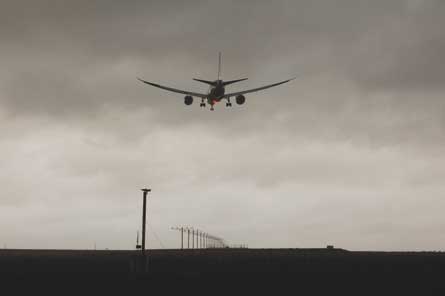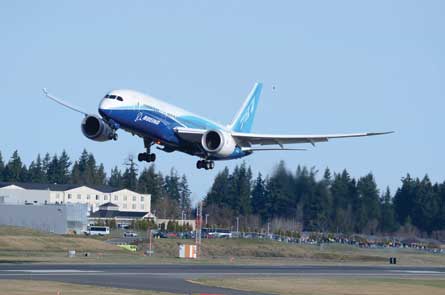On 9 November, test aircraft ZA002 was on final approach to Laredo, Texas after a multi-hour flight to evaluate the 787's fuel inerting nitrogen generation system, when foreign object debris caused an arc in the P100 power panel inside the aft electronics equipment bay underneath the floor of its cabin. There were 42 crew and test participants on board.
The result was a brief but intense fire that lasted just 30s. The incident was over less than 60s later but destroyed the panel and the surrounding insulation and damaged an area of the aircraft's composite structure.
No-one was seriously injured. However, the fire grounded the 787 test fleet for six weeks, revealing an important vulnerability in the redundancy of the 787's electrical architecture and further delaying first delivery.
Test aircraft ZA004 led the return to flying on 23 December, with a patched version of the updated electrical system software, while Federal Aviation Administration personnel resumed flying on board the 787 with Boeing counterparts on 17 January, on a fuel jettison test. ZA003 was first to receive the final update of the version 10.4C ESS software and by 5 March, Boeing confirmed the testing and installation on all six test aircraft was complete.
 |
|---|
© Boeing |
ZA002 undergoes crosswind testing in Iceland |
While the fire sidelined the 787, delaying first delivery from February to August or September, Boeing was progressing steadily through its certification tests following its first landing on European soil at the Farnborough air show in July 2010, despite required inspections of the horizontal stabiliser and slower-than-expected instrumentation change-out.
August brought some of the most dramatic testing for ZA001, with stability and control evaluations of the aircraft's take-off, landing and velocity minimum unstick performance at Edwards AFB in the Mojave Desert in southern California, followed by wet runway trials in Roswell, New Mexico. ZA005 underwent artificial ice shapes trials in late August, evaluating the handling of the aircraft with epoxy foam affixed to the leading edges of the wings and vertical and horizontal stabilisers.
The same month saw the uncontained failure of the Rolls-Royce Trent 1000 "Package A" engine in the engine-maker's test facility at Derby in the UK, prompting design changes to the engine hardware and software and sliding first delivery from "a few weeks into 2011" to the middle of the first quarter, due to the lack of availability of a test engine for Airplane Nine.
 |
|---|
© Flightblogger |
The ZA001 is put through its paces in Everett, Washington |
September was one of the busiest months for flight testing, with the 787 making its second overseas visit, for crosswind testing by ZA002 at Keflavik airport in Iceland; ZA003 undergoing high-humidity environmental control system tests in Fort Lauderdale, Florida; ZA004 completing the flight loads survey in Victorville, California and undergoing community noise evaluations in Glasgow, Montana; and ZA001 subjected to maximum brake energy tests, with Messier-Bugatti and Goodrich brakes, in Roswell.
In October, ZA002 underwent water spray testing to ensure water was not ingested by the engines or other systems. Just before the fire halted test operations in November, ZA005 visited Paris and Amsterdam as part of a sales campaign to win an order for the twinjet from Air France/KLM.
As flight testing resumed in January, tests cut short by November's fire were resumed, including nautical air miles fuel-burn evaluations on ZA005's GEnx-1B engines at Victorville. After resuming flight operations with the FAA, Boeing tasked ZA005, the first of its two General Electric GEnx-1B powered 787s, with a three-city mission running from 22 January until 3 February. It undertook lapse rate take-off trials from near-sea level all the way up to more than 13,300ft (4,025m) above sea level. Trials started at Albuquerque International Sunport in New Mexico at 5,355ft above sea level for the mid-altitude portion of the trials, then moved to the near-sea level Aguadilla, Puerto Rico - location of Rafael Hernandez international airport and its 11,700ft runway, the longest in the Caribbean.
Finally, ZA005 moved to El Alto airport in La Paz, Bolivia - one of the highest commercial airports in the world, at 13,325ft - making the first visit of the 787 to South America. On its return back to Boeing Field in Seattle, the aircraft stopped at George Bush intercontinental airport in Houston, Texas to visit the southern hub of the programme's US launch customer, United Airlines - formerly Continental Airlines - which will receive its first delivery in around March 2012.
For ZA001, much of 2011 has been dedicated to refining S&C characteristics: conducting primary flight control system failures testing in January and S&C certification in February; moving into autopilot, autoflight and autoland testing in March, and limit winds testing in Gander and St Johns in Newfoundland, Canada, in early April; and undergoing certification failures testing in the second half of April. May brought additional S&C evaluations testing, focused on the manoeuvring, trim, lateral, and longitudinal handling characteristics of the aircraft.
ZA002, repaired and returned to Boeing Field, underwent a month-long lay-up process from late February until late March, with production-standard engines and the new electrical software load, as well as the updated foreign object debris-resistant power panels that were also installed on the rest of the test fleet. On 29 March the aircraft performed a polar navigation certification flight, a repeat of a 23 August test to demonstrate ZA002's navigation capabilities at and near the North Pole.
Additionally, ZA004 first flew the Rolls-Royce Package B engine on 21 May, beginning an engine-airframe certification effort to bring the engine's specific fuel consumption within 1% of target with a revised six-stage low-pressure turbine design, high-aspect-ratio blades, relocation of the intermediate-pressure compressor bleed offtake ports and fan outlet guide vanes with improved aerodynamics.
Heading into the final stretch of testing before the programme statement of compliance, when all the submittals are provided to the FAA for review for awarding of the type certificate, ZA102 - Airplane Nine - will lead the 300h functionality and reliability testing campaign, expected to start in early June. This will include extended twin-engine operations certification testing, accounting for the remaining 4% or so of the total 4,300 deliverables owing to the FAA. The Trent 1000 engine received ETOPS certification from the FAA on 9 May.
The aircraft made its first flight on 19 January, then moving to an extended period of maintenance to bring it to its proposed final configuration. In April, ZA003 underwent ETOPS build-up testing, focused on power cooling and single-engine operation.
Boeing had planned to have ZA002, ZA003 and ZA004 participate in functionality and reliability and ETOPS trials, but decided the configuration differences between the test and production standard had become too significant to justify the downtime for modification.
Keep in touch with the twists and turns of Boeing's 787 programme on Jon Ostrower's blog
Source: Flight International























